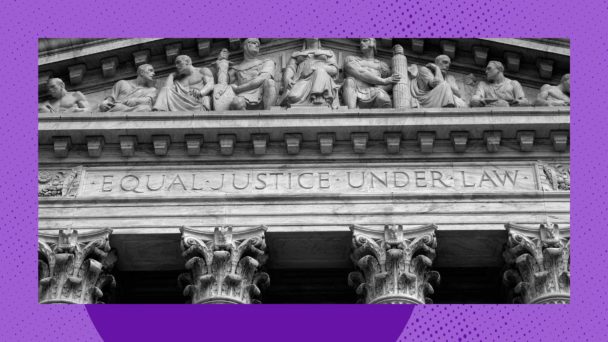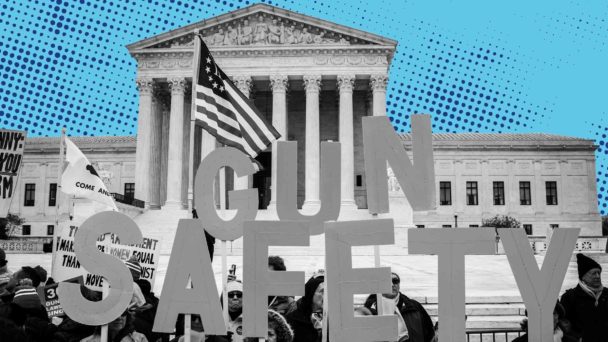Even by the standards of his home state of Texas, Zackey Rahimi is a trigger-happy guy. In February 2020, his ex-girlfriend got a restraining order against him after he pushed her and dragged her into his car, shot at a random bystander who happened to witness this, and then threatened to shoot her too if she told anyone. Then, between December 2020 and January 2021, he was involved in at least five more shootings; most notably when he fired into the air at a Whataburger because his friend’s credit card got declined. Rahimi is like a real-life Yosemite Sam, if the Looney Tunes character also had a history of violence against women. And the Supreme Court will soon decide whether he is constitutionally entitled to a gun.
Federal law makes it a crime for someone subject to a domestic violence restraining order, like Rahimi, to possess a gun. But in United States v. Rahimi, his attorneys from the Office of the Federal Public Defenders argue that the law is unconstitutional because America does not have a historical tradition of disarming domestic abusers. Disturbingly, the Fifth Circuit ruled in Rahimi’s favor and held that it is a correct application of recent Supreme Court precedent.
This argument is especially shocking in light of the fact that women are 500% more likely to be killed when their abuser has access to a gun. Like I explained earlier this year in The Atlantic, the consequence of making legal analysis dependent on a history of misogyny is “as foreseeable as it is deadly.”
Although the notion that the government can’t limit domestic abusers’ access to guns is outrageous, that outrage shouldn’t be directed at Rahimi’s attorneys—public defenders who are making the best arguments they can to keep their client out of the clutches of the criminal legal system. The most appropriate target for your anger is the Supreme Court and its embrace of a legal ideology—originalism—which demands this kind of argument.

When someone suggests you can’t stop the gun violence epidemic because of what colonists thought about muskets
Originalism is a jurisprudential philosophy created and embraced by the conservative legal movement which dictates that the Constitution must be understood today as the public supposedly understood it when it was enacted. The Supreme Court’s overhaul of gun jurisprudence in 2022 was an originalist triumph: Justice Clarence Thomas declared in New York State Rifle & Pistol Association v. Bruen that gun laws are presumptively unconstitutional unless they fit within the country’s “historical tradition of firearm regulation.” Rahimi’s attorneys say the government fails this test, writing that it “has yet to find even a single American jurisdiction that adopted a similar ban while the founding generation walked the earth.”
At oral argument, Justice Elena Kagan quoted that line back to Rahimi’s counsel, federal defender J. Matthew Wright, in disbelief. “Is that what we should be looking for?” Kagan asked. “And if we don’t find that similar ban, we say that the government has no right to do anything?” Wright responded, “I think that’s largely what Bruen says.”
Because of originalism, the arguments now before the Supreme Court appear absurd to anyone with a passing awareness of history. Solicitor General Elizabeth Preolgar contended that the country has historically disarmed dangerous people, and it’s immaterial that the government historically failed to recognize perpetrators of domestic violence as dangerous. This prompted Justice Ketanji Brown Jackson to ask point blank, “What’s the point of going to the Founding Era?” Jackson emphasized the defects of the Bruen standard again during a colloquy with Wright: “I’m a little troubled by having a history and tradition test that also requires some sort of culling of the history so that only certain people’s history counts? Isn’t that a flaw with respect to the test?”
Wright’s answer—that the proper historical inquiry is whether a gun law applied to “someone who would have been understood to be part of the people” at the Founding—was cringe-inducing. It was also a mirror-image of Thomas’s analysis in Bruen, which said “all history is not created equal” and courts should rely on the public’s understanding of the Second Amendment when the Bill of Rights was adopted in 1791 or, potentially (he left this an open question), when the Fourteenth Amendment was ratified in 1868. Ultimately, Kagan and Jackson’s questions are for their fellow justices. After all, this test came not from Wright, but from Clarence Thomas.
Wright had his work cut out for him. Public defenders like Rahimi’s attorneys play a critical role in the legal system, and are routinely denigrated by Republicans for having the audacity to hold that system accountable. Poor people and people of color are disproportionately likely to be charged with a crime and unlikely to be able to afford legal representation, as people accused of crimes are constitutionally entitled to. Overwhelmingly, it’s already-marginalized people who are unceremoniously shuffled into cages, robbed of their liberties, communities, and futures. It’s to those people whom public defenders have a responsibility, which is how Rahimi’s lawyer found himself in the unenviable position of defending his client with the Court’s indefensible standard. He’s not alone: “As we have always done, we will advance all valid and available legal arguments in defense of our clients,” said the chief attorney of the Legal Aid Society’s criminal defense practice after Bruen, “and continue to urge policymakers to focus on real solutions to gun violence, which lie outside of the criminal legal system.”
Barely a decade ago, the Court recognized that “the only difference between a battered woman and a dead woman is the presence of a gun.” And it’s angering that the Court would even consider casting that recognition and the lives of women aside. But it’s the Court, and the lawmakers who enable them, that deserves the public’s anger—not the overworked and underpaid lawyers who are doing what the Constitution demands. In this case: Don’t hate the player, hate the game.




